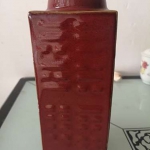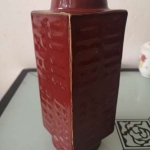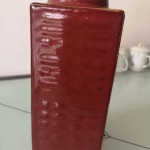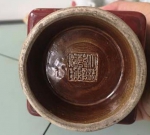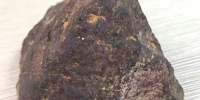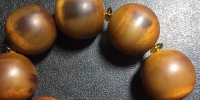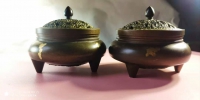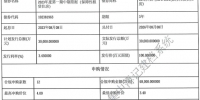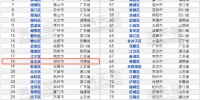古玩城2020精品推荐第九期:清霁红釉八卦琮式瓶
霁红釉,又名祭红、积红,色似初凝的鸡血,深沉安定,莹润均匀,釉中无龟裂纹理,不甚透明,不流釉,不脱口,不开片。它以铜为呈色剂,用普通制釉原料,加入釉灰、氧化锡,生坯挂釉,高温还原烧成。有的霁红釉料配制时,还往往将黄金、珊瑚、玛瑙、玉石等珍贵之物碾成粉末掺入其中,不惜工本。霁红釉是利用铜在还原气氛下呈现红色烧制而成,但这种生产气氛不易控制,因而十分名贵,明中晚期曾一度失传,至清代才恢复烧造,色泽更加艳丽、多样。
Ji red glaze, also known as sacrificial red and accumulated red, is deep and stable with uniform luster. It has no cracking texture in the glaze, is not very transparent, does not flow glaze, does not fall off, does not open. It uses copper as coloring agent, uses common raw materials for glaze making, adds glaze ash and tin oxide, glaze the green body, and reduces the firing at high temperature. Some Ji red glaze preparation, but also often gold, coral, agate, jade and other precious things ground into powder, into which, sparing no cost. Jihong glaze is made of copper in reducing atmosphere, but this kind of production atmosphere is not easy to control, so it is very valuable. It was lost in the middle and late Ming Dynasty, and it was restored in Qing Dynasty. The color is more colorful and diverse.
人们常说,陶瓷是土与火的艺术,在品种繁多、百花争艳的单色釉瓷中,高温红釉瓷的烧制难度最大。它难就难在以铜为呈色剂,而铜的呈色不仅与铜的含量和釉的成分有关,对窑内温度、气氛变化和窑外天气也十分敏感,如果温度和烧制气氛掌握不好,铜就会发黑、变绿,甚至产生“烧飞”现象无法显色。即使用同一配方,在同样的条件下烧制,只因摆放的位置不同,器物的色调也不同。景德镇的祭红釉瓷器非常难以烧制成功,按民间的说法,叫“千窑一宝”,也就是上百炉的窑火中,才能得到一、两件霁红。据成书于清嘉庆年间的《景德镇陶魁》记载,“霁红器,陶户能造霁红者少,无专家,惟好官古户仿之。”道光时期龚旬亦在所编的《景德镇陶歌》中说:“官古窑成重霁红,最难全美费良工。霜天晴画精心合,一样烧百不同。”可知霁红釉烧造难度之大,要烧得纯正之霁红釉并非易事。
It is often said that ceramics are the art of earth and fire. Among the various monochromatic glazed porcelains, the firing of high-temperature red glazed porcelain is the most difficult. It is difficult to use copper as coloring agent, and the coloring of copper is not only related to the content of copper and the composition of glaze, but also very sensitive to the changes of temperature and atmosphere inside the kiln and the weather outside the kiln. If the temperature and firing atmosphere are not well controlled, copper will turn black and green, and even produce "burning fly" phenomenon, which can not show color. That is, using the same formula and firing under the same conditions, the colors of utensils are different because of the different positions. Jingdezhen red glaze porcelain is very difficult to be successfully fired. According to the folk saying, it is called "thousand kilns and one treasure", that is, one or two pieces of Jihong can be obtained from hundreds of kilns. According to the record of Tao Kui in Jingdezhen, which was written in the reign of Jiaqing in Qing Dynasty, "there are few potters who can make Jihong, and there are no experts, but only good officials and ancient households can imitate it." In his Jingdezhen pottery song compiled by Gong Xunyi during the Daoguang period, he said: "it is most difficult to spend good labor in the United States when the ancient official kilns are red. The painting of frost and fine weather is carefully combined, which makes all kinds of difference. " It can be seen that Jihong glaze is difficult to make, and it is not easy to burn pure Jihong glaze.
真正釉色纯正,鲜红艳丽的“铜红”釉瓷器出现在明初永乐、宣德时期,学术界一般称永乐时期的红釉为鲜红釉,称宣德时期的红釉为祭红釉,无论鲜红釉还是祭红釉,都称得上是前无古人、后无来者的顶峰之作。宣德鲜红釉因烧成气氛的不同,有深、浅不同的红色,有宝石红、霁红等名目。有里、外均施红釉和外壁施红釉,里壁为透明釉两类,器物里壁不施红釉者往往胎质较薄,且有的有印花纹饰,唯花纹模糊,红釉釉面多数有橘皮纹。凡较精细规整的器物,其口沿有露出胎釉本色的整齐的“灯草边”,虽亦红白分明,但不如清康熙后仿的那样为特意加涂的白边。较精细规整的器物,近底足处凝釉截齐,垂积釉处呈青灰色,清代仿品则呈凝黑色。凡制作稍粗的器物,留沿不一定有“灯草边”,近底足处由于氧化因素呈绿色。有些器物的棱,往往露白胎而成出筋,如北京故宫博物院的十棱洗,台北故宫博物院的莲瓣卤壶。在有些器物上,釉面有青、紫色窑变斑点,釉表有棕眼、冷纹、开片。明代从成化开始,几乎不再有霁红出现。清康熙时有仿宣德霁红的瓷品,但釉色呈黑红,雍正时仿的则色泽较为润泽艳丽,有的釉表有橘皮纹。釉色浓浅不等,是雍正霁红的工艺缺陷,有深褐、正红、粉红甚至苹果青等色。雍正以后霁红官窑器即很少再出现。
The real pure and bright red "copper red" glaze porcelain appeared in the Yongle and Xuande periods of the early Ming Dynasty. Generally speaking, the red glaze of Yongle period is called bright red glaze, and the red glaze of Xuande period is called sacrificial red glaze. Both the bright red glaze and the sacrificial red glaze can be regarded as the peak works of no one before or after. Due to the different firing atmosphere, Xuande bright red glaze has different red colors, such as ruby red and Jihong. There are two types of red glaze on the inside and outside and transparent glaze on the outer wall. The inner wall without red glaze is usually thin, and some have printing patterns, but the patterns are fuzzy. Most of the red glaze glaze surface has orange peel patterns. For the more delicate and regular objects, there are neat "lamp grass edges" showing the true color of the body glaze. Although they are also distinct in red and white, they are not as white as those specially painted after the reign of Emperor Kangxi of the Qing Dynasty. The glaze near the bottom of the ware is cut evenly, the vertical glaze is green gray, and the imitation of Qing Dynasty is black. If the utensils are made slightly thick, there may not be "lamp grass edge" on the edge, and the place near the bottom foot is green due to oxidation factors. The edges of some utensils, such as the ten edged washing at the Palace Museum in Beijing and the lotus pot in Taipei, are often made out of the white fetus. On some utensils, there are blue and purple spots on the glaze surface, and there are brown eyes, cold lines and open pieces on the glaze surface. From Chenghua in Ming Dynasty, Jihong almost no longer appears. During the reign of Emperor Kangxi in the Qing Dynasty, there were porcelain products imitated by Xuande Jihong, but the glaze color was black red. In Yongzheng period, the color of porcelain imitated was more moist and gorgeous, and some glaze surface had orange peel pattern. The color of glaze varies from thick to light, which is the defect of Yongzheng Jihong, including dark brown, positive red, pink and even apple green. After Yongzheng, Jihong official kiln ware rarely appeared.
明清以降,瓷器被广泛应用到祭祀用器之中,祭红因“如朝霞霁色”又称“霁红”。据《景德镇陶录》载:“今厂器做‘霁红’,而陶俗皆作‘济红’。其实‘祭红’为是。盖宣窑造此,初为祭郊日坛用也。”本品为乾隆年期窑霁红之代表,造型尊贵典雅,曲线优美怡人,釉水凝厚莹亮;釉面密布细小的棕眼。圈足修削工整,无聚釉垂流之患。如此品格高超的霁红釉八卦琮式瓶在当时亦属难得,后世对此更是不可企及,制瓷水平的高峰往往是一时诸条件之最佳综合所致,缺一不可。
Since the Ming and Qing Dynasties, porcelain has been widely used in sacrificial utensils. According to the "Jingdezhen pottery record", today's wares are "Jihong", and the pottery custom is "Jihong". In fact, "offering sacrifices to the red" means "sacrificing the red". It was made in gaixuan kiln at the beginning of the festival This product is the representative of Jihong kiln in Qianlong period. It is noble and elegant in shape, beautiful and pleasant in curve. The glaze is thick and bright, and the glaze is densely covered with small brown eyes. The ring foot is trimmed neatly, without the problem of glaze vertical flow. Such high-quality Jihong glaze Bagua Cong bottle was also rare at that time, and it was beyond the reach of later generations. The peak of porcelain making level was often caused by the best combination of various conditions at a time, and none of them was indispensable.
企业联系电话:400-681-6118
